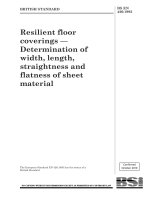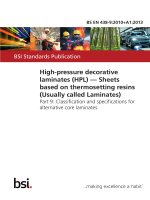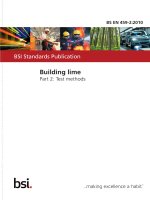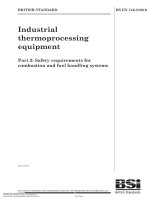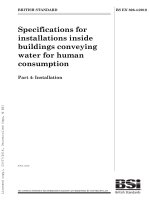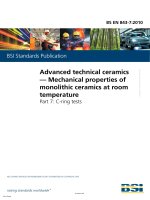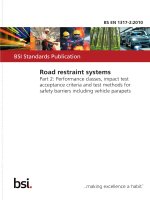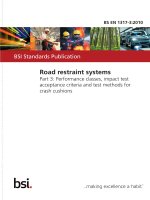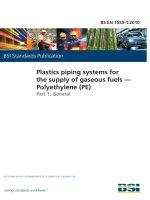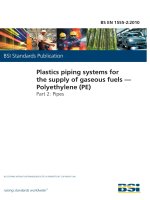Bsi bs en 62058 31 2010
Bạn đang xem bản rút gọn của tài liệu. Xem và tải ngay bản đầy đủ của tài liệu tại đây (1.42 MB, 26 trang )
BS EN 62058-31:2010
BSI Standards Publication
Electricity metering
equipment (a.c.) —
Acceptance inspection
Part 31: Particular requirements for static
meters for active energy (classes 0,2 S, 0,5
S, 1 and 2, and class indexes A, B and C)
BRITISH STANDARD
BS EN 62058-31:2010
National foreword
This British Standard is the UK implementation of EN 62058-31:2010. It was
derived by CENELEC from IEC 62058-31:2008. Together with BS EN 6205811:2010, it supersedes BS EN 61358:1996 which is withdrawn.
The CENELEC common modifications have been implemented at the
appropriate places in the text and are indicated by tags (e.g. }~ ).
The UK participation in its preparation was entrusted to Technical Committee
PEL/13, Electricity Meters.
A list of organizations represented on this committee can be obtained on
request to its secretary.
This publication does not purport to include all the necessary provisions of a
contract. Users are responsible for its correct application.
© BSI 2010
ISBN 978 0 580 59108 2
ICS 17.220.20; 91.140.50
Compliance with a British Standard cannot confer immunity from
legal obligations.
This British Standard was published under the authority of the Standards
Policy and Strategy Committee on 30 September 2010.
Amendments/corrigenda issued since publication
Date
Text affected
EUROPEAN STANDARD
EN 62058-31
NORME EUROPÉENNE
June 2010
EUROPÄISCHE NORM
ICS 17.220; 91.140.50
Supersedes EN 61358:1996 (partially)
English version
Electricity metering equipment (a.c.) Acceptance inspection Part 31: Particular requirements for static meters for active energy
(classes 0,2 S, 0,5 S, 1 and 2, and class indexes A, B and C)
(IEC 62058-31:2008, modified)
Equipement de comptage
de l'électricité (a.c.) Contrôle de réception Partie 31: Exigences particulières
pour compteurs statiques d'énergie active
(de classes 0,2 S, 0,5 S, 1 et 2
et d’indices de classe A, B et C)
(CEI 62058-31:2008, modifiée)
Wechselstrom-Elektrizitätszähler Annahmeprüfung Teil 31: Besondere Anforderungen
an elektronische Zähler für Wirkenergie
(Klassen 0,2 S, 0,5 S, 1 und 2
und Klassenzeichen A, B und C)
(IEC 62058-31:2008, modifiziert)
This European Standard was approved by CENELEC on 2010-06-01. CENELEC members are bound to comply
with the CEN/CENELEC Internal Regulations which stipulate the conditions for giving this European Standard
the status of a national standard without any alteration.
Up-to-date lists and bibliographical references concerning such national standards may be obtained on
application to the Central Secretariat or to any CENELEC member.
This European Standard exists in three official versions (English, French, German). A version in any other
language made by translation under the responsibility of a CENELEC member into its own language and notified
to the Central Secretariat has the same status as the official versions.
CENELEC members are the national electrotechnical committees of Austria, Belgium, Bulgaria, Croatia, Cyprus,
the Czech Republic, Denmark, Estonia, Finland, France, Germany, Greece, Hungary, Iceland, Ireland, Italy,
Latvia, Lithuania, Luxembourg, Malta, the Netherlands, Norway, Poland, Portugal, Romania, Slovakia, Slovenia,
Spain, Sweden, Switzerland and the United Kingdom.
CENELEC
European Committee for Electrotechnical Standardization
Comité Européen de Normalisation Electrotechnique
Europäisches Komitee für Elektrotechnische Normung
Management Centre: Avenue Marnix 17, B - 1000 Brussels
© 2010 CENELEC -
All rights of exploitation in any form and by any means reserved worldwide for CENELEC members.
Ref. No. EN 62058-31:2010 E
BS EN 62058-31:2010
EN 62058-31:2010
–2–
Foreword
The text of document 13/1432/FDIS, future edition 1 of IEC 62058-31, prepared by IEC TC 13, Electrical
energy measurement, tariff- and load control, was submitted to the IEC-CENELEC parallel vote.
A draft amendment, prepared by the Technical Committee CENELEC TC 13, Equipment for electrical
energy measurement and load control, was submitted to the formal vote.
The combined texts were approved by CENELEC as EN 62058-31 on 2010-06-01.
EN 62058-31:2010, together with EN 62058-11:2010, supersedes EN 61358:1996.
Attention is drawn to the possibility that some of the elements of this document may be the subject of
patent rights. CEN and CENELEC shall not be held responsible for identifying any or all such patent
rights.
The following dates were fixed:
– latest date by which the EN has to be implemented
at national level by publication of an identical
national standard or by endorsement
(dop)
2011-06-01
– latest date by which the national standards conflicting
with the EN have to be withdrawn
(dow)
2013-06-01
This European Standard has been prepared under a mandate given to CENELEC by the European
Commission and the European Free Trade Association and covers essential requirements of
EC Directive 2004/22/EC. See Annex ZZ.
Annexes ZA and ZZ have been added by CENELEC.
__________
Endorsement notice
The text of the International Standard IEC 62058-31:2008 was approved by CENELEC as a European
Standard with agreed common modifications.
BS EN 62058-31:2010
EN 62058-31:2010
–3–
Annex ZA
(normative)
Normative references to international publications
with their corresponding European publications
The following referenced documents are indispensable for the application of this document. For dated
references, only the edition cited applies. For undated references, the latest edition of the referenced
document (including any amendments) applies.
NOTE When an international publication has been modified by common modifications, indicated by (mod), the relevant EN/HD
applies.
Publication
Year
Title
EN/HD
Year
IEC 62053-21
2003
Electricity metering equipment (a.c.) Particular requirements Part 21: Static meters for active energy
(classes 1 and 2)
EN 62053-21
2003
IEC 62053-22
2003
Electricity metering equipment (a.c.) Particular requirements Part 22: Static meters for active energy
(classes 0,2 S and 0,5 S)
EN 62053-22
2003
IEC 62058-11
2008
Electricity metering equipment (AC) Acceptance inspection Part 11: General acceptance inspection
methods
EN 62058-11
2010
ISO/IEC Guide 98
1995
Guide to the expression of uncertainty in
measurement (GUM)
-
-
BS EN 62058-31:2010
EN 62058-31:2010
–4–
Annex ZZ
(informative)
Coverage of Essential Requirements of EC Directives
This European Standard has been prepared under the mandate M/374 given to CENELEC by the
European Commission and within its scope the standard covers methods for statistical verification of
conformity with the metrological requirements in connection the Modules F, D and H1.
EN 62058-11 specifies sampling plans, schemes and systems for lot-by-lot inspection by attributes or
variables. In addition, a test procedure for 100% inspection is specified, that can be used if the lot size is
too small for sampling inspection or when sampling inspection has to be discontinued.
Considering the Part 11, EN 62058-31 specifies particular requirements for static electricity meters,
including the tests to be performed, the sampling plans applicable and the performance criteria.
Table ZZ.1 provides the relationship between the Essential requirements of the MID and the stipulations
of the EN 62058 series.
Compliance with this standard provides one means of conformity with the specified essential
requirements of the Directives concerned.
WARNING: Other requirements and other EC Directives may be applicable to the products falling within
the scope of this standard.
BS EN 62058-31:2010
EN 62058-31:2010
–5–
Table ZZ.1 – Relationship between the Essential requirements of the MID
and the stipulations of the relevant standards
MID Annex I
Subject
EN 62058-11
EN 62058-21
EN 62058-31
5.6 Accuracy
tests, Table Z2
5.6 Accuracy
tests, Table Z2
5.7 Verification
of the register
5.7 Verification
of the register
NOTE
The text in this column is for
orientation. For the full text see the
MID.
1
Allowable Errors
1.1
Under rated operating conditions and in
the absence of disturbance
–
1.2
Under rated operating conditions and in
the presence of disturbance
–
–
–
1.3
Climatic, mechanical and EM
environment and other influence
quantities to be specified by the
manufacturer
–
–
–
1.3.1
Climatic environments, upper and lower
temperature limit
–
–
–
1.3.2
Mechanical environments, vibration
and shock
–
–
–
1.3.3
Electromagnetic environments, unless
otherwise laid down in the appropriate
instrument-specific annexes.
–
–
–
1.3.4
Other influence quantities
–
–
–
1.4
Carrying out the tests
–
–
–
1.4.1
Basic rules for testing and
determination of errors
–
5.6,
Accuracy test
5.6,
Accuracy test
1.4.2
Ambient humidity
–
–
–
2
Reproducibility
–
–
–
3
Repeatability
–
4.3
4.3
4
Discrimination and Sensitivity
–
–
–
5
Durability
–
–
–
6
Reliability
–
–
–
7
Suitability
5.3
AC voltage test
5.3
AC voltage test
7.1
7.2
7.3
7.4
7.5
No feature likely to facilitate fraudulent
use, possibilities for unintentional
misuse minimal
–
–
–
Suitable for intended use under
practical working conditions, no
unreasonable demand of the user
–
–
–
Errors of a utility measuring instrument
at flows or currents outside the
controlled range not unduly biased.
–
–
–
When the measurand is constant over
time, the measuring instrument shall be
insensitive to small fluctuations of the
value of the measurand, or shall take
appropriate action.
N.A.
N.A.
N.A.
–
–
–
Robust and materials of construction
suitable for the intended use
conditions.
BS EN 62058-31:2010
EN 62058-31:2010
MID Annex I
7.6
–6–
Subject
EN 62058-11
EN 62058-21
EN 62058-31
–
–
–
Protection against corruption
–
–
–
Metrological characteristics not
influenced in any inadmissible way by
the connection to it of another device,
by any feature of the connected device
itself or by any remote device that
communicates with the measuring
instrument.
–
–
–
–
–
–
–
–
–
–
–
–
–
–
–
–
–
–
–
5.2
5.2
N.A.
N.A.
N.A.
Designed so as to allow the control of the
measuring tasks after the instrument has
been placed on the market and put into
use.
Software that is critical for the
metrological characteristics identifiable.
Metrological characteristics not
inadmissibly influenced by the
associated software.
8
8.1
8.2
Hardware component critical for
metrological characteristics designed
so that it can be secured.
Security measures to provide evidence
of an intervention.
8.3
Software that is critical for metrological
characteristics shall be identified as such
and shall be secured.
Software identification.
Evidence of an intervention available for
a reasonable period of time.
8.4
8.5
9
9.1
Measurement data, critical software and
metrologically important parameters
stored or transmitted adequately
protected against accidental or
intentional corruption.
For utility measuring instruments the
display of the total quantity supplied or
the displays from which the total quantity
supplied can be derived, whole or partial
reference to which is the basis for
payment, shall not be able to be reset
during use.
Information to be borne by and to
accompany the instrument
Shall bear the following inscriptions:
-
manufacturers mark or name;
information in respect of accuracy.
When applicable:
-
-
9.2
information in respect of the
conditions of use;
measuring capacity;
measuring range;
identity marking;
number of the EC-type examination
certificate or the EC design
examination certificate;
information whether or not additional
devices providing metrological
results comply with the provisions of
this Directive on legal metrological
control.
For too small instruments, marking on
packaging and in any accompanying
documents
BS EN 62058-31:2010
EN 62058-31:2010
–7–
MID Annex I
9.3
Subject
EN 62058-11
EN 62058-21
EN 62058-31
–
–
–
Accompanying information on
-
operation
and where relevant
-
-
-
rated operating conditions;
mechanical and electromagnetic
environment classes;
the upper and lower temperature
limit, whether condensation is
possible or not, open or closed
location;
instructions for installation,
maintenance, repairs, permissible
adjustments;
instructions for correct operation
and any special conditions of use;
conditions for compatibility with
interfaces, sub-assemblies or
measuring instruments.
9.4
Utility meters do not require individual
instruction manuals.
–
–
–
9.5
Decimal scale interval
–
–
–
9.6
Material measure
N.A.
N.A.
N.A.
9.7
Units of measurement and symbols in
accordance with Community legislation
–
–
–
9.8
Marks and inscriptions clear, nonerasable, unambiguous and nontransferable.
–
–
–
Indication of result
–
–
–
10
10.1
Display or hard copy
N.A.
N.A.
N.A.
10.2
Indication of result clear and
unambiguous. Easy reading.
N.A.
N.A.
N.A.
10.3
Hard copy easily legible and not
erasable
N.A.
N.A.
N.A.
10.4
Direct sales trading transactions
N.A.
N.A.
N.A.
10.5
Fitted with a metrologically controlled
display accessible without tools to the
consumer.
5.7 Verification
of the register
5.7 Verification
of the register
5.7 Verification
of the register
Further processing of data to conclude
the trading transaction
N.A.
N.A.
N.A.
11.1
Durable record of the measurement
result (other than utility meter)
N.A.
N.A.
N.A.
11.2
Durable proof of the measurement
result
N.A.
N.A.
N.A.
–
–
–
The reading of this display is the
measurement result that serves as the
basis for the price to pay.
11
12
Conformity evaluation
Designed so as to allow ready
evaluation of its conformity with the
appropriate requirements of this
Directive.
Annex MI-003
ACTIVE ELECTRICAL ENERGY
METERS
1
Accuracy
–
–
–
2
Rated operating conditions
–
–
–
BS EN 62058-31:2010
EN 62058-31:2010
MID Annex I
3
–8–
Subject
EN 62058-11
MPEs
4
EN 62058-21
EN 62058-31
5.6 Accuracy
tests, Table Z2
5.6 Accuracy
tests, Table Z2
5.7 Verification
of the register
5.7 Verification
of the register
Permissible effect of disturbances
–
–
–
4.1
General – Special EM environment
–
–
–
4.2
Effect of disturbances of long duration
–
–
–
Reversed phase sequence
–
–
–
Voltage unbalance (only applicable to
polyphase meters)
–
–
–
Harmonic contents in the current
circuits
–
–
–
DC and harmonics in the current
circuit
–
–
–
Fast transient bursts
–
–
–
Magnetic fields
–
–
–
HF (radiated RF) electromagnetic
field;
–
–
–
Conducted disturbances introduced by
radio-frequency fields
–
–
–
Oscillatory waves immunity
–
–
–
4.3
Permissible effect of transient
electromagnetic phenomena
–
–
–
4.3.1
Behavior during and immediately after
a disturbance
–
–
–
–
–
–
–
–
–
–
–
–
–
–
–
Recovery
Critical change value
4.3.2
5
Critical change value for overcurrent
Suitability
5.1
Measurement error below the rated
operating voltage
5.2
Display of total energy
-
sufficient number of digits
not resettable during use
5.3
Retain energy register reading for 4
months
5.4
Running with no load
5.5
Starting
–
5.4 Test of noload condition
5.4 Test of noload condition
–
5.5 Starting,
Table Z1
5.5 Starting,
Table Z1
6
Units
–
–
–
7
Putting into use
–
–
–
Specifies 100%
testing and
sampling
inspection
methods to
support
modules F, D
and H1
–
–
CONFORMITY ASSESSMENT
B + F or B + D or H1.
–9–
BS EN 62058-31:2010
EN 62058-31:2010
CONTENTS
INTRODUCTION...................................................................................................................10
1
Scope ............................................................................................................................. 11
2
Normative references ..................................................................................................... 11
3
Terms, definitions, symbols and abbreviations................................................................ 11
4
Test conditions ............................................................................................................... 11
5
4.1 Place of inspection ................................................................................................ 11
4.2 Reference conditions............................................................................................. 11
4.3 Uncertainty of measurement of percentage error ................................................... 13
4.4 Cover and seal ...................................................................................................... 14
Inspection procedure ...................................................................................................... 14
6
5.1 Tests to be performed and inspection methods...................................................... 14
5.2 Preliminary tests and pre-conditioning ................................................................... 14
5.3 Test No. 1: AC voltage test.................................................................................... 15
5.4 Test No. 2: Test of no-load condition ..................................................................... 15
5.5 Test No. 3: Starting ............................................................................................... 15
5.6 Tests No. 4…9: Accuracy tests.............................................................................. 16
5.7 Test No. 10: Verification of the register ................................................................. 18
5.8 Meters for special services .................................................................................... 18
5.9 Other tests ............................................................................................................ 19
Criteria for lot acceptance non-acceptance, disposal of unacceptable lots ...................... 19
7
Test record and evaluation ............................................................................................. 19
Bibliography.......................................................................................................................... 21
Table 1 – Voltage and current balance for polyphase meters ................................................ 12
Table 2 – Reference conditions............................................................................................. 12
Table 3 – Percentage error limits corrected with uncertainty ................................................. 13
Table 4 – Acceptance tests and inspection methods ............................................................. 14
Table 5 – AC voltage test...................................................................................................... 15
Table 6 – Value of current for starting test ............................................................................ 15
Table 7 – Accuracy test points and percentage error limits .................................................. 16
Table 8 – Inspection sheet .................................................................................................... 20
Table Z1 – Value of current for starting test for meters of class index A, B and C.................................15
Table Z2 – Accuracy test points and limits of errors for meters of class index A, B and C....................16
Table Z3 – Example for determining the percentage error limits to be applied.......................................18
BS EN 62058-31:2010
EN 62058-31:2010
– 10 –
INTRODUCTION
This standard together with IEC 62058-11 cancels and replaces IEC 61358, Acceptance
inspection for direct connected alternating-current static watt-hour meters for active energy
(Classes 1 and 2).
– 11 –
BS EN 62058-31:2010
EN 62058-31:2010
ELECTRICITY METERING EQUIPMENT (a.c) –
ACCEPTANCE INSPECTION –
Part 31: Particular requirements for static meters
for active energy (classes 0,2 S, 0,5 S, 1 and 2 }, and class indexes A, B
and C~)
1
Scope
This part of IEC 62058 specifies particular requirements for acceptance inspection of newly
manufactured direct connected or transformer operated static meters for active energy
(classes 0,2 S, 0,5 S, 1 and 2) delivered in lots in quantities above 50. The method of
acceptance of smaller lots should be agreed upon by the manufacturer and the customer.
The process described herein is primarily intended for acceptance inspection between the
manufacturer and the purchaser.
}This European standard applies to meters of accuracy classes 0,2 S, 0,5 S, 1 and 2, as well as to meters
of class indexes A, B and C.~
NOTE
2
It can also be used for other purposes, for example to support initial verification.
Normative references
The following referenced documents are indispensable for the application of this document.
For dated references, only the edition cited applies. For undated references, the latest edition
of the referenced document (including any amendments) applies.
IEC 62053-21:2003, Electricity metering equipment (a.c.) – Particular requirements – Part 21:
Static meters for active energy (classes 1 and 2)
IEC 62053-22:2003, Electricity metering equipment (a.c.) – Particular requirements – Part 22:
Static meters for active energy (classes 0,2 S and 0,5 S)
IEC 62058-11:2008, Electricity metering equipment (a.c.) – Acceptance inspection – Part 11:
General acceptance inspection methods
ISO/IEC GUIDE 98: 1995, Guide to the Expression of Uncertainty in Measurement
EN 50470-1:2006, Electricity metering equipment (a.c.) - Part 1: General requirements, tests and test conditions Metering equipment (class indexes A, B and C)
EN 50470-3: 2006, Electricity metering equipment (a.c.) – Part 3: Particular requirements – Static meters for active
energy (class indexes A, B and C)
3
Terms, definitions, symbols and abbreviations
For the purposes of this document, the terms, definitions, symbols and abbreviations in
IEC 62058-11 apply.
4
4.1
Test conditions
Place of inspection
Subclause 5.15 of IEC 62058-11 applies.
4.2
Reference conditions
The tests shall be carried out under the following conditions:
BS EN 62058-31:2010
EN 62058-31:2010
– 12 –
Table 1 – Voltage and current balance for polyphase meters
Class of meter
Condition
0,2 S
0,5 S
Each of the voltages between phase and neutral and between any two
phases shall not differ from the average corresponding voltage by more
than
1
2
±1%
Each of the currents in the conductors shall not differ from the average
current by more than
±1%
±2%
The phase displacements of each of these currents from the
corresponding phase-to-neutral voltage, irrespective of the phase angle,
shall not differ from each other by more than
2°
Table 2 – Reference conditions
Influence quantity
Permissible tolerances
for meters of class
Reference value
0,2 S
0,5 S
Ambient temperature
Reference temperature or, in its
absence, 23 °C a
Voltage
Reference voltage
Frequency
Reference frequency
Phase sequence
L1 – L2 – L3
-
Voltage unbalance
All phases connected
-
Wave-form
Sinusoidal voltages and currents
Continuous magnetic induction
of external origin
Equal to zero
1
2
± 0,3 %
± 0,5 %
± 2 °C
± 1,0 %
± 0,3 %
± 0,3 %
Distortion factor less than
2,0 %
2,0 %
2,0 %
3,0 %
Induction value which causes a variation
of error not greater than: ± 0,3 % b
Magnetic induction of external
origin at the reference frequency
Magnetic induction equal to zero
± 0,1 %
± 0,1 %
± 0,2 %
± 0,3 %
but should in any case be smaller than
b
0,05 mT
Electromagnetic RF fields,
30 kHz to 2 GHz
Equal to zero
Operation of accessories
No operation of accessories
Conducted disturbances,
induced by radio frequency
fields, 150 kHz to 80 MHz
Equal to zero
< 1 V/m
<1V
a
If the tests are made at a temperature other than the reference temperature, including permissible
tolerances, the results shall be corrected by applying the appropriate temperature coefficient of the meter.
b
The test consists of:
1) for a single-phase meter, determining the errors first with the meter normally connected to the mains and
then after inverting the connections to the current circuits as well as to the voltage circuits. Half of the
difference between the two errors is the value of the variation of error. Because of the unknown phase of
the external field, the test should be made at 0,1 I b resp. 0,05 I n at unity power factor and 0,2 I b resp. 0,1
I n at 0,5 power factor;
2) for a three-phase meter, making three measurements at 0,1 I b resp. 0,05 I n at unity power factor, after
each of which the connection to the current circuits and to the voltage circuits are changed over 120°
while the phase sequence is not altered. The greatest difference between each of the errors so
determined and their average value is the value of the variation of error.
}For meters of class index A, B and C, the values in Table 1, specified for meters of class 1 and class 2
apply, whereas the values in Table 2, specified for meters of class 2, class 1 and class 0,5 S apply
respectively~
BS EN 62058-31:2010
EN 62058-31:2010
– 13 –
4.3
Uncertainty of measurement of percentage error
The measuring process shall be such that the uncertainty of the measurement of the
th
percentage error should not exceed 1/5 of the limit of percentage error for the given test
point at reference conditions.
For determining the uncertainty of measurement, see ISO/IEC GUIDE 98.
If the uncertainty exceeds this limit, then inspection by variables cannot be used. Only
inspection by attributes will be possible and the limits of percentage error shall be corrected
using the following formula:
ecorr ( I , cos ϕ) = 6 / 5 • e( I , cos ϕ) − U
where:
•
e( I , cos ϕ) is the limit of percentage error for the given test point at reference conditions;
•
U is the measurement uncertainty.
EXAMPLE
If, for a given test point, the limit of percentage error at reference conditions is
e( I , cos ϕ) = ± 2 % ; and
U = 0,5 %; then
ecorr ( I , cos ϕ) = ± (6 / 5 • 2,0 − 0,5) = ±1,9% .
Instead of the original limit, this corrected limit applies.
Table 3 gives percentage error limits corrected with uncertainty of measurement, using the
formula above.
Table 3 – Percentage error limits corrected with uncertainty
Percentage
error
limit %
0,6
0,5
0,45
0,4
0,35
0,3
0,25
0,2
0,15
0,1
± 3,0
± 3,0
± 3,0
± 3,0
± 3,0
± 3,0
± 3,0
± 3,0
± 3,0
± 3,0
± 3,0
± 2,5
± 2,4
± 2,5
± 2,5
± 2,5
± 2,5
± 2,5
± 2,5
± 2,5
± 2,5
± 2,5
± 2,0
± 1,8
± 1,9
± 1,95
± 2,0
± 2,0
± 2,0
± 2,0
± 2,0
± 2,0
± 2,0
± 1,5
± 1,2
± 1,3
± 1,35
± 1,4
± 1,45
± 1,5
± 1,5
± 1,5
± 1,5
± 1,5
± 1,0
± 0,6
± 0,7
± 0,75
± 0,8
± 0,85
± 0,9
± 0,95
± 1,0
± 1,0
± 1,0
± 0,6
± 0,12
± 0,22
± 0,27
± 0,32
± 0,37
± 0,42
± 0,47
± 0,52
± 0,57
± 0,6
± 0,5
0
± 0,1
± 0,15
± 0,2
± 0,25
± 0,3
± 0,35
± 0,4
± 0,45
± 0,5
± 0,4
0
0
± 0,03
± 0,08
± 0,13
± 0,18
± 0,23
± 0,28
± 0,33
± 0,38
± 0,3
0
0
0
0
± 0,01
± 0,06
± 0,11
± 0,16
± 0,21
± 0,26
± 0,2
0
0
0
0
0
0
0
± 0,04
± 0,09
± 0,14
NOTE
Uncertainty of measurement of percentage error, %
In any case, the uncertainty should not exceed half of the percentage error limit.
BS EN 62058-31:2010
EN 62058-31:2010
4.4
– 14 –
Cover and seal
The meters shall be inspected and tested with their covers on and manufacturer's seal
unbroken.
NOTE If testing of mechanical aspects is required, the conditions should be agreed between the manufacturer
and the purchaser.
5
Inspection procedure
5.1
Tests to be performed and inspection methods
Table 4 specifies the characteristics to be inspected, the classification of nonconformities, and
the inspection method(s) to be applied, with reference to the sampling plans given in
IEC 62058-11.
Table 4 – Acceptance tests and inspection methods
Test No.
1
2
3
Test
AC voltage
test
No-load
Starting
Classification of
nonconformities
Critical
Non-critical
Inspection methods available
a
IEC 62058-11
sampling plan
Lot-by-lot inspection by attributes,
single sampling, Ac = 0
or
Table 6
Isolated lot inspection by attributes,
procedure A, Ac = 0
Table 18
Lot-by-lot inspection by attributes,
single sampling, AQL = 1,0
or
Table 2
Lot-by-lot inspection by attributes,
double sampling, AQL = 1,0
or
Table 7
Isolated lot inspection by attributes,
single or double sampling,
Procedure A, LQ = 5,0
or
Table 17
Isolated lot inspection by attributes,
single or double sampling,
Procedure B, LQ = 5,0
Table 20
Non-critical
As for test No. 2
As for test No. 2, in addition
4…9
a
Accuracy
10
Meter
constant
-
Other tests
Non-critical
Lot-by-lot inspection by variables,
“s” method, AQL = 1,0
or
Table 24
Lot-by-lot inspection by variables,
“ σ ” method, AQL = 1,0
Table 26
Critical
As for test No. 1
See 5.9
-
100 % inspection can always be used, see Clause 6 of IEC 62058-11.
If, for the different tests, the sampling plans give different sample sizes, then the number of
samples shall be equal to the largest sample size. The smaller sample shall be chosen from
the larger sample randomly.
}See also EN 62058-11, 5.5.~
5.2
Preliminary tests and pre-conditioning
The meters selected for inspection shall be visually examined in order to verify that they
belong to the same type, that their specified markings are correct and that none of them
BS EN 62058-31:2010
EN 62058-31:2010
– 15 –
shows signs of damage. The meters shall be in conformity with the type approval and they
shall have the same voltage and current charactesristics.
Before the tests, the meters shall be energized at reference voltage and loaded with the
current specified below, at unity power factor, to reach thermal stability.
The value of the current shall be 0,1 I b for direct connected meters or 0,1 I n for transformer
operated meters respectively
The tests shall be performed in the order below.
} For meters of class indexes A, B and C, the value of current shall be Itr. ~
5.3
Test No. 1: AC voltage test
The a.c. voltage test shall be carried out in accordance with Table 5.
The test voltage shall be substantially sinusoidal, having a frequency between 45 Hz and
65 Hz, and applied for 2 s. The power source shall be capable of supplying at least 500 VA.
The rise time and the fall time of the test voltage shall be ≤ 2 s. The auxiliary circuits with
reference voltage equal to or below 40 V shall be connected to earth.
During this test, no flashover, disruptive discharge or puncture shall occur.
Table 5 – AC voltage test
Test voltage r.m.s for meters of
insulation class
I
II
1,6 kV
3,2 kV
Points of application of the test voltage
Between on the one hand, all the current and voltage circuits as well as the
auxiliary circuits whose reference voltage is over 40 V, connected together,
and, on the other hand, earth.
If the manufacturer provides evidence that the test has been already performed on each item
before acceptance inspection, then this test does not have to be performed.
5.4
Test No. 2: Test of no-load condition
The test of no-load condition shall be carried out in accordance with 8.3.2 of IEC 62053-21
and IEC 62053-22 respectively.
}For meters of class index A, B and C, the test of no-load condition shall be carried out in accordance with
EN 50470-3, 8.7.9.3.~
5.5
Test No. 3: Starting
When the meter is energized at reference voltage, (and in case of polyphase meters, with
balanced load) and connected as shown in the diagram of connections, it shall start and
continue to register at the current given in Table 6.
Table 6 – Value of current for starting test
Meters for
Direct connection
Connection through
current transformers
Class of meter
0,2 S
0,5 S
0,001 I n
0,001 I n
Power factor
1
2
0,004 I b
0,005 I b
1
0,002 I n
0,003 I n
1
}For meters of class index A, B and C, instead of the values of Table 6, the values
of Tabble Z.1 apply:
Table Z1 – Value of current for starting test for meters of class index A, B and C
Meters for
Meters of class index
Power
factor
A
B
C
Direct connection
0,05 Itr
0,04 Itr
0,04 Itr
1
Connection through current transformers
0,06 Itr
0,04 Itr
0,02 Itr
1
~
BS EN 62058-31:2010
EN 62058-31:2010
5.6
– 16 –
Tests No. 4…9: Accuracy tests
The accuracy tests for single- and polyphase shall be carried out at the test points specified in
Table 7, in the order shown in the table, without waiting for the thermal equilibrium to be
attained between the measurements.
Table 7 – Accuracy test points and percentage error limits
Value of current for
Limits of percentage error
for meters of class
Power
factor
Applicable
for meter
type
Load
(in case of
polyphase
meters)
0,01 I n
resp.
0,02 I n a
1
Single- and
polyphase
Balanced
± 0,4
± 1,0
± 1,5
± 2,5
Ib
In
1
Single- and
polyphase
Balanced
± 0,2
± 0,5
± 1,0
± 2,0
6
Ib
In
0,5
Single- and
polyphase
Balanced
± 0,3
± 0,6
± 1,0
± 2,0
7
Ib
In
1
Polyphase
Single
phase b
± 0,3
± 0,6
± 2,0
± 3,0
8
Ib
In
1
Polyphase
Single
phase c
± 0,3
± 0,6
± 2,0
± 3,0
9
I max
I max
1
Single- and
polyphase
Balanced
± 0,2
± 0,5
± 1,0
± 2,0
Test
No.
Direct
connected
meters
Transformer
operated
meters
4
0,05 I b
5
0,2 S
0,5 S
1
2
a
0,01 I n for class 0,2 S and 0,5 S meters and 0,02 I n for class 1 and 2 meters.
b
The meter shall be supplied with three phase symmetrical voltage. The current shall be applied to any of the
phases.
c
The meter shall be supplied with three phase symmetrical voltage. The current shall be applied to a phase
different from the phase in test 7.
} For meters of class index A, B and C, instead of the values of the values of Table 7, the values of Table
Z2 apply:
Table Z2 – Accuracy test points and limits of errors for meters of class index A, B and C
Value of current for direct
connected and
transformer operated
meters
Power
factor
Applicable
for meter
type
Load
(in case of
polyphase
meters)
4
Imin
1
Single- and
polyphase
5
10 Itr
1
6
10 Itr
7
Test No.
Percentage error limits for
for meters of class index
A
B
C
Balanced
± 2,5
± 1,5
± 1,0
Single- and
polyphase
Balanced
± 2,0
± 1,0
± 0,5
0,5
Single- and
polyphase
Balanced
± 2,0
± 1,0
± 0,5
10 Itr
1
Polyphase
Single
phase a
± 3,0
± 2,0
± 1,0
8
10 Itr
1
Polyphase
Single
phase b
± 3,0
± 2,0
± 1,0
9
Imax
1
Single- and
polyphase
Balanced
± 2,0
± 1,0
± 0,5
a
The meter shall be supplied with three phase symmetrical voltage. The current shall be applied to any of the
phases.
b
The meter shall be supplied with three phase symmetrical voltage. The current shall be applied to a phase
different from the phase in test 7.
~
– 17 –
BS EN 62058-31:2010
EN 62058-31:2010
} The values of Table Z2 are taken from EN 50340-3, Table 4 and Table 5, Percentage error limits at
reference conditions.
To ensure that the requirements of EN 50340-3, Table 8, Maximum permissible error (MPE), are also
met, and with this the essential requirements of the MID are met, the actual percentage error limits to be
used during conformity assessment shall be established using the method described below.
For each test point, the values of variation of percentage error due to temperature, voltage and frequency
variation, established during type testing, shall be subtracted from the MPE using the formula:
2
2
2
ecalc ( I , cos ϕ ) = MPE 2 − δ Type
(T ,I , cos ϕ ) − δ Type
( U ,I , cosϕ ) − δ Type
( f ,I , cosϕ )
Where:
ecalc ( I , cos ϕ )
is the value of calculated limit of percentage error under reference conditions;
MPE
is the value of maximum permissible error taken from EN 50340-3, Table 8 for the
given test point;
δ Type (T ,I , cos ϕ ) is the value of the variation of percentage error due to variation of temperature,
established during type testing;
δ Type ( U , I , cos ϕ ) is the value of the variation of percentage error due to variation of voltage, established
during type testing;
δ Type ( f , I , cos ϕ )
is the value of the variation of percentage error due to variation of frequency,
established during type testing.
The actual limit of percentage error to be applied for each test point shall be the lesser of the value shown
in Table Z2, and the value ecalc ( I , cosϕ ) calculated as described above.
An eventual correction of the percentage error limits, due to uncertainty of the measurement of
percentage error as described in 4.3, also applies.
During manufacturing, the values of the variation of percentage error due to temperature, voltage and
frequency variation shall be established in adequate intervals to ensure that they are essentially same as
established during type testing.
EXAMPLE
A meter of class index A, manufactured for the temperature range of 5 °C to 30 °C is tested.
The columns of Table Z3 show the following:
-
column 1: the number of test, as identified in Table Z2;
-
column 2: the values of the mpe, taken from EN 50340-3, Table 8;
-
column 3: the values of temperature variation, established during the type test;
-
column 4: the values of voltage variation, established during the type test;
-
column 5: the values of frequency variation, established during the type test;
-
column 6: the calculated values of percentage error limits;
-
column 7: the percentage error limits taken from Table Z2.~
BS EN 62058-31:2010
EN 62058-31:2010
– 18 –
}Table Z3 – Example for determining the percentage error limits to be applied
Tes
t
No.
δ Type (T , I , cosϕ )
δ Type ( U , I , cosϕ )
δ Type ( f , I , cosϕ )
ecalc ( I , cosϕ )
+
3,5
+ 0,5
- 0,2
+ 0,1
± 3,46
+
3,5
+ 0,3
- 0,2
+ 0,1
± 3,48
+
3,5
+ 0,5
- 0,2
+ 0,1
± 3,46
+
4,0
+ 0,4
- 0,2
+ 0,1
± 3,97
+
4,0
+ 0,4
- 0,2
+ 0,1
± 3,97
+
3,5
+ 0,3
- 0,2
+ 0,1
± 3,48
MP
E
4
5
6
7
8
9
As the values of
e( I , cosϕ )
± 2,5
± 2,0
± 2,0
± 3,0
± 3,0
± 2,0
e( I , cosϕ ) , taken from Table Z2 are smaller than the values ecalc ( I , cosϕ ) calculated
from the MPE taking into account the values of variation of percentage error due to temperature, voltage
and frequency variation, established during type testing, the values e( I , cosϕ ) of Table Z2 shall be
used.
If the meter is intended for a wider temperature range, then the calculation has to be performed for each
temperature range, and the smallest percentage error limits – out of all the calculated values
ecalc ( I , cosϕ ) and the values e( I , cosϕ ) of Table Z2 – shall be used.~
5.7
Test No. 10: Verification of the register
This test shall be performed by measuring a sufficient amount of energy, to verify that the
accuracy of incrementing the register reading is better than ± 1,0 %.
The test shall be done for each meter on at least one tariff register.
5.8
Meters for special services
If the meter is designed to measure bidirectional energy flow, then tests 3…9 shall be
performed also in the other energy direction. However, in the case when the type test results
show similar results for both energy directions, then repeating tests 3 and 4 is deemed to be
sufficient.
If the meter is designed for multiple reference voltages, then tests 2...9 shall be performed
both at the lowest and the highest reference voltage.
If a – polyphase – meter is intended to support multiple service modes, then tests 3 and 4
shall be perfomed for each service:
•
if the meter is intended for a three-phase three-wire service, then the tests shall be
performed by applying three phase symmetrical voltage and balanced three phase current;
•
if the meter is intended for a single-phase two-wire service, then the tests shall be
performed in each phase which will be used on the field, with single phase voltage and
current, as marked on the meter;
NOTE 1
•
If any of the phases can be used, then the tests should be performed in each phase.
if the meter is intended for a two element service, then the starting tests shall be
performed in each two phases which will be used on the field, as marked on the meter;
NOTE 2
If any two phases can be used, then the tests should be performed in all possible combinations.
– 19 –
5.9
BS EN 62058-31:2010
EN 62058-31:2010
Other tests
The manufacturer and the customer may agree to perform testing of any additional
functionality and mechanical aspects.
The inspection methods – 100 % testing, inspection by attributes or inspection by variables –
and the acceptance conditions shall be agreed by the manufacturer and the customer.
6
Criteria for lot acceptance non-acceptance, disposal of unacceptable lots
See IEC 62058-11, 5.18 and the relevant clauses for each inspection scheme.
7
Test record and evaluation
The test results of the sample shall be recorded and evaluated in the inspection sheet given
in the Table 8 below.
NOTE
Tests agreed between the manufacturer and the purchaser may be added.
For larger sample sizes, several inspection sheets may be necessary. The results shall be
evaluated on the last sheet. In this case, in the line “Result” write “Continued on next
inspection sheet”. The cell “Lot number” can be used for numbering the inspection sheets
including test results of a lot.
For double sampling plans, two sets of inspection sheets may be necessary.
BS EN 62058-31:2010
EN 62058-31:2010
– 20 –
Table 8 – Inspection sheet
1 st / 2
nd
Meter
sample
Inspection by attributes
Inspection by attributes or variables
Test number
Last
figures of
serial no.
1
10
2
3
4
5
6
7
8
1
2
3
4
5
6
7
8
9
10
11
12
13
14
…
Number of
nonconformities
Number of
nonconforming
meters a
Acceptance number
0
0
Rejection number
1
1
Inspector
Measurement uncertainty
Percentage error limits ±
Sample mean
Date
xi
Standard deviation
si
f s or f σ
Lot number
MSSD or MPSD
pˆ
pˆ
pˆ
Ui
Li
i
n
∑ pˆ i =
i =1
Result: Accept /
Reject / 2 nd sample
a
See IEC 62058-11, 7.4.4.1.
p* =
9
– 21 –
BS EN 62058-31:2010
EN 62058-31:2010
Bibliography
IEC 62052-11:2003, Electricity metering equipment (a.c.) – General Requirements, tests and
test conditions – Part 11: Metering equipment
NOTE Harmonized as EN 62052-11:2003 (not modified).
___________
This page deliberately set blank
This page deliberately left blank
